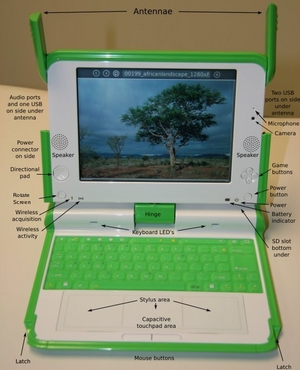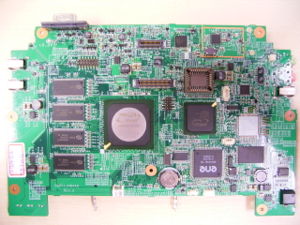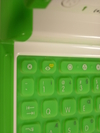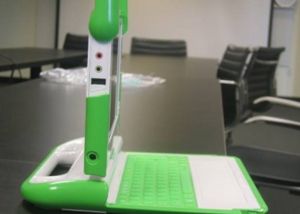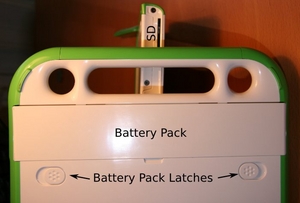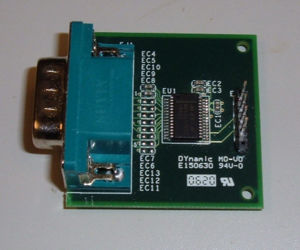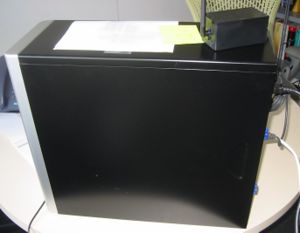Hardware specification/lang-fr
| Traduction de Hardware specification | original |
| deutsch | english | español | français | italian | 日本語 | 한글 | português | русский indonesia +/- | changes |
- This is an on-going translation
Configuration matérielle
Le portable XO est au centre du programme One Laptop Per Child. Après deux ans de développement, le lancement de la production de masse approche, avec pour l'instant plusieurs milliers de machines de Beta test (B2) mis à la disposition à la fois des développeurs et des enfants dans les écoles des pays participants. Son design vient de connaitre une dernière évolution mineure pour coller aux avancées technologiques.
Caractéristiques
Dimensions :
- Dimensions : 242mm × 228mm × 30mm (approximatives, sujettes à modifications)
- Poids : moins de 1.5 kg (sujet à modifications)
- Fonctionnalités : écran pivotant bimodal transmissif/réflectif ; résistant à la poussière et à l'eau
Architecture :
- CPU : AMD Geode LX-700@0.8W (datasheet)
- Fréquence processeur : 433 MHz
- Compatibilité : jeu d'instructions Athlon (comprenant MMX et 3DNow! Enhanced) et instructions additionnelles spécifiques à Geode
- Northbridge : interface mémoire et PCI intégrée au processeur Geode
(info)
- Carte graphique : intégrée avec processeur Geode; architecture à mémoire unifiée
- Southbridge : AMD CS5536 (datasheet)
- Mémoire DRAM : 256 MiB de mémoire dynamique
- Type de mémoire : Dual – DDR333 – 166 MHz
- BIOS : 1024 KB SPI-interface flash ROM; LinuxBIOS open-source BIOS; Open Firmware bootloader
- Mémoire de masse : 1024 MiB SLC NAND flash, high speed flash controller
- Stockage : pas de lecteurs internes
- Contrôleur intégré: ENE KB3700
- CaFE ASIC (Camera Flash Enabler chip liée une caméra à haute performance, interfaces SD et mémoire flash NAND). Marvell 88ALP01: CaFE Specification
Affichage :
- Ecran LCD : écran TFT 7.5” Dual-mode
- Zone d'affichage : 152.4 mm × 114.3 mm
- Résolution : 1200×900 à 200 dpi
- Affichage monochrome : mode monochrome réflectif haute résolution
- Affichage couleurs : mode couleurs transmissif 800x600 et supérieur
- Consommation : 0.1 Watt sans le retro-éclairage; 0.2-1.0 Watt avec le rétro-éclairage
- Le processeur graphique DCON avec une mémoire permettant à l'affichage de rester fonctionnel alors que le processeur central est hors-tension. L'affichage et cette puce sont à la base de notre architecture à basse consommation. L'ordinateur est fonctionnel et relaie le trafic mesh alors que le processeur central et la majeure partie de la carte mère sont mis régulièrement hors-tension. Le processeur graphique intègre également des fonctions de deswizzling et d'anti-aliasing en mode couleurs. Vous pouvez voir cette photo de l'affichage même si elle ne rend pas compte de la réalité.
- Note : les images web sont actuellement étalonnées de manière à ce qu'une image d'une résolution d'à peu près [800x600] remplisse la fenêtre du navigateur.
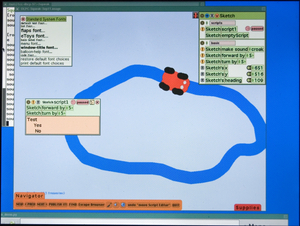
Périphériques intégrés :
- Clavier : 70 touches de 1.2mm ; protection plastique étanche
- Normes du clavier
- Photos des différents normes de clavier du B3 : US International, Thai, Arabic, Spanish, Brazilian Portuguese, Nigeria, Urdu, French
- Touches de contrôle du curseur : pavé de contrôle du curseur 5 touches (4 touches directionnelles plus Entrée)
- Touchpad : ALPS Electric touchpad avec capacité tablette pour saisie au stylet
- Audio : Analog Devices AD1888, AC97-compatible audio codec; stereo avec deux haut-parleurs intégrés; entrée micro mono amplifiée par le système Analog Devices SSM2302
- Connexion sans-fil : Marvell Libertas 88W8388+88W8015, compatible 802.11b/g; deux antennes rotatives ajustables ; supports diversity reception
- LEDs d'activité : alimentation, batterie, activité WiFi; visibles dans les deux modes d'utilisation
- Caméra : résolution de 640x480, 30FPS, Omnivision OV7670. La caméra et son driver utilisent l'AGC et la balance automatique des couleurs pour permettre d'utiliser la caméra comme une cellule photoélectrique à des fins éducatives.
- Independent and undefeatable by software display of microphone and camera recording status
Connectique externe :
- Alimentation : 2-pin DC-input supportant des courants de 10 à 20 V. Elle supporte des fluctuations d'intensité de -40 à 39 V.
- Prise casque : audio jack stéréo standard 3.5mm 3-pin
- Micro : jack micro mono standard 3.5mm 2-pin avec trois modes :
- Sensor, DC w. 2.5 V (3K ohm d'impédance) bias voltage for switches, resistive sensors, etc.
- Sensor, DC w. no bias voltage for measuring voltages (0 - 3 V)
- External Microphone, AC w. bias voltage
- Expansion: 3 Type-A USB-2.0 connectors; MMC/SD Card slot
- Maximum power: 1 A (total)
Battery:
- Fully-enclosed “hard” case; user removable
- Pack type: 4 Cells, 6V series configuration
- Two chemistries:
- NIMH, with a capacity of 16.5 Watt-hours
- LiFeP, with a capacity of 22 Watt-hours
- Electronics integrated with pack provide:
- Identification
- Battery charge and capacity information
- Thermal and over-current sensors along with cutoff switch to protect battery
- Cycle life: Minimum 2,000 charge/discharge cycles (to 50% capacity of new, IIRC).
- Power Management will be critical
BIOS/loader:
- Open Firmware is used as the firmware, including hardware initialization and fast resume.
Environmental specifications:
- Temperature: somewhere in between typical laptop requirements and Mil spec; exact values have not been settled
- Humidity: Similar attitude to temperature. When closed, the unit should seal well enough that children walking to and from school need not fear rainstorms or dust.
- Altitude: -15m to 3048m (operating), -15m to 12192m (non-operating)
- Shock: 125g, 2ms, half-sine (operating) 200g, 2ms, half-sine (non-operating)
- Random vibration: 0.75g zero-to-peak, 10Hz to 500Hz, 0.25 oct/min sweep rate (operating); 1.5g zero-to-peak, 10Hz to 500Hz, 0.5 oct/min sweep rate (nonoperating)
- 2mm plastic walls (1.3mm is typical for most systems).
Regulatory requirements:
- The usual US and EU EMI/EMC requirements will be met.
- The laptop and all OLPC-supplied accessories will be fully UL and is RoHS compliant.
Support Hardware
Serial Adapter
- 3.3V TTL to RS-232 Level shifter
Calendrier de développement du XO
The XO laptop hardware development schedule has two more test unit builds (Beta Test 3 and Beta Test 4), before a final test build (C Test 1) on the final production line and mass production. The Beta Test 3 build scheduled for early May will be the first one providing the processor and memory capabilities of the production version.
Pre-production Test Systems (CTest-1, or C1)
This build is of 300 laptops produced as a test of the manufacturing process on the main production line, and should happen starting August 6th, 2007. Slip resistance rubber feet will be added as will more easily replacable bunny ears (just two screws per ear after bezel removal). The hinge stop that appeared in B3/B4 will be eliminated or reduced (this is used to the stop the display at perpendicular before it tilts back further). Bean texture will be applied to the exterior white parts and "satin" texture to the the rest of the laptop plastic parts. A C1 laptop will be nearly identical to the production unit ...
Beta Test 4 Systems (BTest-4, or B4)
This build which ran from June 20-25, 2007, was the final chance to fix hardware and mechanical problems that were detected in the Beta Test 3 build of the XO. 2000 units were built.
Texture was added to the upper handle bar, the hinge tilt was increased by 7 degrees, the hinge "squeak" was eliminated, the rabbit ears click in place when put in the "down" position", the slight camera vignetting seen in B3 was eliminated, and minor modifications were made to the motherboard.
Beta Test 3 Systems (BTest-3, or B3)
This build, scheduled for May 2007, is the first to use an updated design for the laptop. Noticeable improvements over BTest-2 include:
- A faster, lower power processor: the Geode LX-700
- 64 KB I/64 KB D of L1 Cache, 128 KB of L2 Cache (vs. 32 KB of L1 cache)
- Faster processor and memory clock (433/333 vs. 366/266)
- 1.5 W typ. vs. 3 W typ.
- Much better graphics processor, including support for rotated blits and depth conversion
- More memory: 256 MB of SDRAM (vs. 128 MB)
- extra screws
- insert molded rubber ears for better robustness
- a smaller battery cavity to improve robustness, make the bumper lines cleared
- 10-20V input voltage tolerance.
- new bumper tooling to allow the bumpers to be made of polycarbonate (as opposed to PC/ABS) with 3mm thickness and ribbing to 1.8mm (was 2mm and 1.2mm respectively)
- colored XO on the back cover (400 different color combinations so kids can distinguish their laptops from each other
- A keyboard that is much better to type on
- Finally a touchpad that is much easier to use and much more responsive
- a steel plate inside the entire keyboard base to reduce the feeling of flimsiness
- a flipped USB connector so each side has the same way up for a USB key or device
- A new hinge design allows greater tilt of the screen
- An improved case design (addressing strength)
A very small number of BTest-3 units (around a hundred) were built, all were used for hardware and low level software development.
Beta Test 2 Systems (BTest-2, or B2)
Approximately 2500 systems were built by Quanta and are being distributed. These are fully functional machines with CaFE ASICs, and reflect some, but not all of the learning and improvements from testing of BTest-1. Much more information about the BTest-2 systems can be found in the BTest-2 Release Notes. Some of the details of the hardware design are to support the OLPC Human Interface Guidelines.
BTest-2 systems are almost identical visually with BTest-1. BTest-3 will have more substantial physical differences. An easy way to tell the difference between BTest-1 and BTest-2 is that BTest-1 keyboards have white lettering, and BTest-2 has black lettering.
Beta Test 1 Systems (BTest-1)
Approximately 875 systems were built by Quanta and were distributed. These are fully functional machines, but built before the rigorous testing that will now take place. Much more information about the BTest-1 systems can be found in the BTest-1 Release Notes.
Pre-BTest boards
A small number of pre-BTest boards were built in preparation for building complete BTest systems. Developer information about B-test boards are here.
Alpha Test Prototype Electronics
Power up of the first OLPC electronics prototype boards occurred April 15, 2006. Power and ground testing continued over the weekend, and formal debug and BIOS bring up started Monday, April 17, 2006 at Quanta Computer's labs in Taipei, Taiwan. By Wednesday, April 19, Linux was booting on the first generation prototypes.
Photographs:
- Component side OLPC circuit board
- Back side of the OLPC circuit board
- Picture of Linux running with circuit board in the lab
- Picture of the screen of Linux running on the OLPC circuit board; fittingly, it shows a Chinese desktop
See also
Environmental Impact
Hardware
Support
Formerly part of this page:
Hardware uniqueness
Hardware design
Les serveurs des écoles
Bien que le portable soit central dans le fonctionnement de OLPC, le serveur de l'école occupe une place importante dans l'architecture du réseau. OLPC fabriquera et distribuera des serveurs aux écoles en plus des portables pour permettre une extension du stockage des données et de la puissance de calcul de chaque portable, ainsi que la mise en place d'une bibliothèque locale et d'un portail mesh vers Internet.
Contrairement au portable, le serveur de l'école est plus un ensemble de services qu'une plateforme matérielle. De la même manière que pour le portable, OLPC travaillera en collaboration avec des partenaires du monde industriel pour fournir une plateforme matérielle à bas coût pour l'utilisation du logiciel recommandé. Mais contrairement au partenariat passé pour la fabrication du portable, ce dernier ne sera pas exclusif ; tous les pays seront libres (et même encouragés) à concevoir et à fabriquer leurs propres serveurs d'école aussi bien au niveau matériel que logiciel.
XS
Ce sera le serveur d'école mis au point par OLPC. Sa conception est pratiquement achevée mais reste pour l'instant au point mort pour des raisons de partenariats avec les constructeurs. La production devrait être lancée d'ici au printemps 2008. Voir la fiche technique.
XSX
C'est le prototype de serveur d'école, construit pour les premiers essais sur le terrain. Il sera fabriqué à partir de composants standards, et sera surdimmensionné - par rapport aux serveurs de production - pour simplifier les premières demandes de logiciel système. Voir la fiche technique et l'implémentation.
